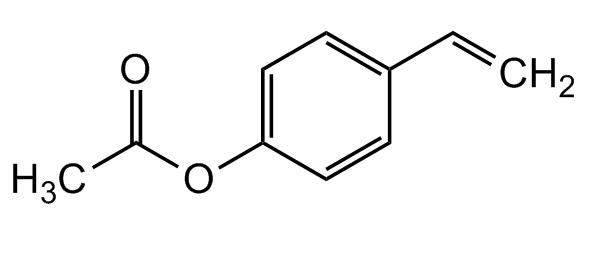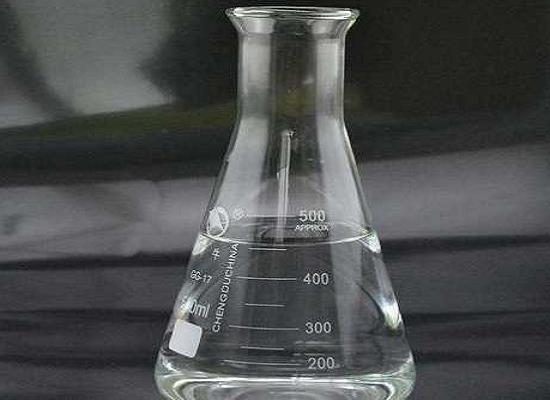4-Acetoxystyrene: A Versatile Monomer with Applications in Polymerization and Immunosensing
General Description
4-Acetoxystyrene is a clear and colorless liquid with the ability to homopolymerize and copolymerize with styrene and other compatible monomers. It finds applications in the production of curing agents for epoxy resins and in the synthesis of epoxy resins. Additionally, it is used in a novel immunosensing strategy based on surface-initiated atom-transfer radical polymerization (SI-ATRP) combined with electrochemical detection. However, 4-Acetoxystyrene exhibits moderate toxicity and can cause skin irritation, eye discomfort, and respiratory irritation. It also poses a threat to aquatic life. Therefore, proper safety precautions are necessary when handling this substance.

Figure 1. 4-Acetoxystyrene
Versatility in Polymerization
4-Acetoxystyrene is a clear and colorless liquid with specific properties. It is primarily known as the acetic acid ester of p-vinylphenol. One notable characteristic of 4-Acetoxystyrene is its ability to homopolymerize, similar to styrene, which means it can form a polymer composed solely of 4-Acetoxystyrene units. Additionally, it can also be copolymerized with styrene and other monomers that are compatible with styrene copolymerization. When subjected to aqueous emulsion, 4-Acetoxystyrene can undergo both homopolymerization and copolymerization reactions. In this process, the resulting polymer does not need to be isolated as it can be directly hydrolyzed using a base. The hydrolysis leads to the formation of homopolymers and copolymers of p-vinylphenol. Homopolymers and copolymers of p-vinylphenol find applications as curing agents for epoxy resins. They are also used in the synthesis of epoxy resins through their reaction with epichlorohydrin. This demonstrates the versatility of 4-Acetoxystyrene and its importance in the production of various materials with desirable properties. 1
Applications in Immunosensing
4-Acetoxystyrene is a monomer used in a novel immunosensing strategy based on surface-initiated atom-transfer radical polymerization (SI-ATRP) combined with electrochemical detection. 4-Acetoxystyrene is chosen for ATRP due to its ability to provide acetoxyl groups, which can be converted into phenolic hydroxyl groups for electrochemical detection in the presence of tyrosinase. The process begins with the immobilization of initiator molecules on an electrode surface, followed by a controlled radical polymerization reaction of 4-Acetoxystyrene at 60°C. This leads to the growth of long-chain polymeric materials, increasing the concentration of phenolic hydroxyl groups. The enhanced electrochemical signal output is observed as a result. The polymerization conditions, such as temperature, duration, monomer concentration, and catalyst/monomer ratio, have been optimized. The success of the in situ surface-initiated ATRP has been confirmed through scanning electron microscope (SEM) images and X-ray photoelectron spectroscopy (XPS) analysis. Cyclic voltammetry investigation demonstrates well-defined oxidation and reduction peaks on the electrode surface, corresponding to the redox behavior of catechol/o-quinone. This approach has been extended to immune recognition, achieving a detection limit of 0.3 ng mL^(-1) for rabbit immunoglobulin G (IgG) as a model antigen. Despite the limited availability of IgG antibodies, this technology has the potential to be expanded for the detection of other proteins and DNA. The SI-ATRP of 4-acetoxystyrene has been successfully achieved on a self-assembled layer modified gold electrode. 2
Health Risks
4-Acetoxystyrene exhibits moderate toxicity when ingested and slight toxicity when in contact with the skin. It is known to be an irritant to the eyes and can cause discomfort upon exposure. The liquid form of 4-Acetoxystyrene is combustible, and when subjected to decomposition by heat, it releases acrid smoke and irritating vapors. Ingesting 4-Acetoxystyrene can be harmful to health. It may lead to adverse effects if swallowed, including skin irritation, allergic reactions on the skin, and serious eye irritation. Furthermore, it has the potential to induce respiratory irritation upon inhalation. It is essential to note that 4-Acetoxystyrene poses a threat to aquatic life with long-lasting effects. Therefore, proper precautions should be taken to prevent its release into water sources or ecosystems. Overall, the toxicity profile of 4-Acetoxystyrene highlights the importance of handling this substance with care and implementing appropriate safety measures to minimize the risk of adverse health effects or environmental harm. 3
Reference
1. Wang T, Yan J, Yuan H, et al. Tg Confinement Effect of Random Copolymers of 4-tert-Butylstyrene and 4-Acetoxystyrene with Different Compositions. ACS Macro Lett. 2019;8(10):1280-1284.
2. Yuan L, Wu Y, Shi H, Liu S. Surface-initiated atom-transfer radical polymerization of 4-acetoxystyrene for immunosensing. Chemistry. 2011;17(3):976-983.
3. 4-Acetoxystyrene. National Center for Biotechnology Information (2024). PubChem Compound Summary for CID 75821.
Related articles And Qustion
Lastest Price from 4-Acetoxystyrene manufacturers

US $50.00-10.00/kg2025-09-02
- CAS:
- 2628-16-2
- Min. Order:
- 1kg
- Purity:
- 99%,Electronic grade(Single metal impurity≤ 100ppb)
- Supply Ability:
- 100kg

US $0.00-0.00/kg2025-04-23
- CAS:
- 2628-16-2
- Min. Order:
- 1kg
- Purity:
- 99%
- Supply Ability:
- 10ton/month



